|
Micscape Mini Review - Three budget commercial LED dimmers compared for microscopy projects.
by David Walker, UK
|
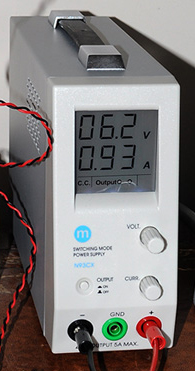 LEDs have allowed the microscopy hobbyist to experiment with a wide variety of lighting projects both for the compound and stereo microscope. Typical projects include converting a microscope's illumination from incandescent sources, fluorescence studies, epi work or exploring recently reported lighting techniques that are particularly suited to LEDs such
as the
work of Dr Kevin Webb using concentric LED rings or the multi-mode lighting techniques described by Prof. Jörg Piper and Timm Piper.
LEDs have allowed the microscopy hobbyist to experiment with a wide variety of lighting projects both for the compound and stereo microscope. Typical projects include converting a microscope's illumination from incandescent sources, fluorescence studies, epi work or exploring recently reported lighting techniques that are particularly suited to LEDs such
as the
work of Dr Kevin Webb using concentric LED rings or the multi-mode lighting techniques described by Prof. Jörg Piper and Timm Piper.
Many hobbyists like myself with only basic electronics knowledge often prefer to adopt LED power supplies that do not involve building our own. There are many good resources describing the pros and cons of the so-called 'constant current' and 'constant voltage' designs including T Rand Collins's recent series on Micscape. One recommended approach and the one I've used to date
is to use a good quality regulated variable V/I supply (shown right, a Maplin N93CX) with a suitable
resistor in circuit. I like this method because the accurate display of V/I gives some understanding of how the system works and can accurately reset preferred settings. (The supply also doubles up as a high quality unit for tungsten microscope lamps of modest wattage.)
One disadvantage of the above method is that it's not ideally suited for independent intensity control of more than one LED system* and a recent project required three compact independent controllers. The commercial controllers are better suited, so I browsed the online suppliers to see what budget models were available. I'm an admitted latecomer
to this approach as from the microscopy forums,
many hobbyists use these. I was surprised at the wide variety of very cheap and versatile controllers available—probably driven by the adoption of LED lighting in various guises in the home. (*Unless install further controllers such as potentiometers in each LED supply line.)
In case of use to fellow tinkerers with LEDs also unfamiliar with typical commercial controllers, I briefly compare below the relative merits of three typical examples. Note that all three require an appropriate power supply. I initially used the variable power supply above with a multimeter across LEDs to assess their performance and to check the calculated dropping resistor if required was working as anticipated.
The lab supply was then replaced with a spare regulated 'wall wart'. For any potential supply it's best to check the voltage off-load to ensure regulated.
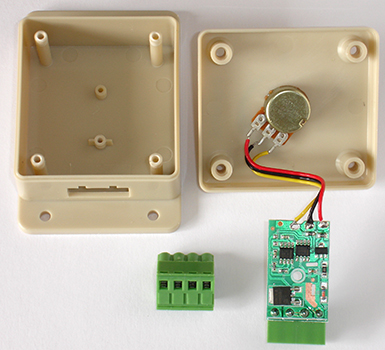
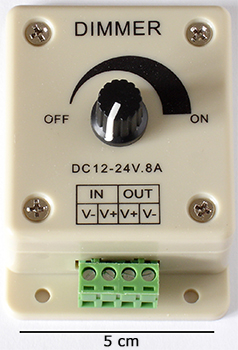 LED dimmer with analogue intensity control
LED dimmer with analogue intensity control
Cost: £1-42 with free shipping from China. ca. three weeks to arrive.
Source: eBay UK (Chinese sourced supplier e.g. 'homeoutlet').
Design features: DC in 12 - 24V, 8A. (In practice it works with a 7V supply.)
From inspection of the board, the active electronics are as follows as described from online datasheets - 09N03LA 'power MOSFET', LM358 'precision timer', 78L05 'positive regulator'.
Pros: Continuous variation with visual indication of where intensity is set.
Ideal for where regular smooth control of the intensity is required.
Ideal for the 12V halo LED rings with a 12V supply.
Cons: Bulkier than the digital options but still compact.
Best immobilised on bench when wires fitted.
No off switch so a given setting not retained but zero light at lowest setting.
Less suited to single high power LED use which requires appropriate dropping resistor and PSU.
Notes: If multiple LED lighting is desired, its simple modular construction could suit rehousing its electronics from more than one into a dedicated custom box to reduce space.
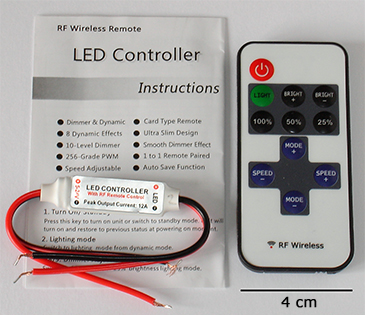 LED dimmer with RF wireless remote for incremental intensity control and stroboscopic features
LED dimmer with RF wireless remote for incremental intensity control and stroboscopic features
Cost: £2-99 with free shipping within UK.
Source: eBay UK (Chinese sourced supplier e.g. 'homeoutlet' but item in UK).
Design features: DC in 5 - 24V, 12A.
Pros: Very compact.
Has 25, 50 and 100% light settings as well as ca. 17 increments.
The remote operation maybe useful under some conditions coupled say with remote camera operation.
Remembers the light setting last used when switch back on.
The wide voltage range down to 5V makes it more suited to single high power LED use with suitable dropping resistor and PSU.
Cons: Need to become familiar with modes to ensure don't enter the stroboscopic modes.
The multiple stroboscopic features may be unwanted.
No indication of what intensity level is set.
No battery is supplied for the remote. (A 3V CR2025 is required.)
Not suited for multiple LED control because the remote control acts on all of them. (Based on the two examples I have. I'm uncertain what the '1 to 1 Remote Paired' in the instructions refers to.)
Notes: Unsure of the long term reliability of the very basic dimple control buttons.
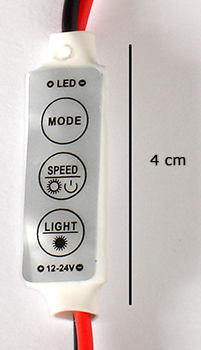 LED dimmer with in-line incremental intensity control and stroboscopic features
LED dimmer with in-line incremental intensity control and stroboscopic features
Cost: £1-80 with free shipping from within the UK
Source: eBay UK (e.g. supplier 'yoopar').
Design features: DC in 12 - 24V, 8A.
Pros: Very compact.
Seven intensity settings plus off.
Remembers the light setting last used when switch back on.
Ideal for the 12V halo LED rings rated at 12V with 12V supply.
Cons: Buttons on the small in-line unit rather fiddly if changing the intensity or power on/off regularly. Supporting on a firm base helps.
Need to become familiar with modes to ensure don't enter the stroboscopic modes.
No instructions, not clear initially how to turn off (hold power button for more than two seconds).
No indication of what intensity level is set; the seven levels may be limiting for some uses requiring very fine control.
The multiple stroboscopic features may be unwanted.
Less suited to single high power LED use which requires appropriate dropping resistor and PSU.
Notes: Unsure of the long term reliability of the very basic dimple control buttons.
Examples of controllers in use
|
Car 'halo' 12V LED rings
Shown right are three of the in-line controllers being used to independently control three LED rings (40, 60 and 80 mm). Their very compact nature suit this type of project, although may change out for the analogue controllers with knob for smoother lighting control at the expense of a larger footprint.
This is a project in progress. The three LED rings from the centre outwards provide phase II, annular oblique and darkfield at this focus plane for the Zeiss 16/0.4 Neofluar phase objective but only one or two rings would be used at any one time. This uses the concentric LED rings concept described by Dr Kevin Webb on an inverted microscope (see August 2016 Micscape for my own trials with an upright microscope) with the mixed lighting
techniques described by Prof. Jörg Piper and Timm Piper. (Piper and Piper did not describe the use of such rings but Dr Beck suggested the use of concentric LED rings for their lighting modes.)
With mixed lighting techniques, careful control of the relative intensities is vital hence the need for the independent LED controllers. The LED rings shown are all white, pre-cut acetate coloured filters can be lain over each ring aided by the ease of access.
The LED rings only take small currents and three can be supplied by one 12V regulated 'wall wart' power supply as shown here. The rings are designed to be used on a 12V supply without additional dropping resistors which form part of the ring electronics.
|
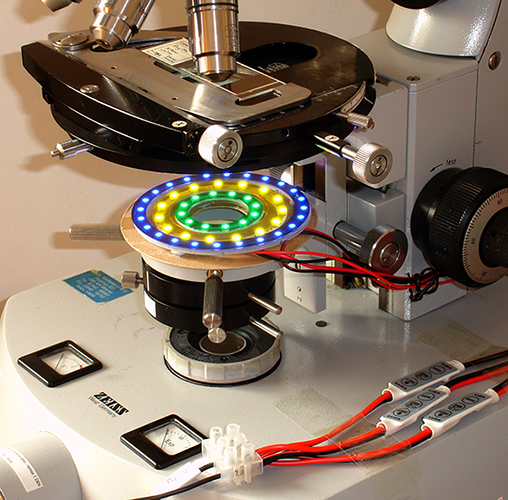
|
|
Single high power LEDs for e.g. main lighting (white), fluorescence (monochromatic) etc.
High power single LEDs typically operate at full intensity with ca. 3 - 4 V and currents from 0.5 to 1.5A. The controllers described above operate off a nominal minimum of 12V+ (two models) or 5V+ so single power LEDs mounted on appropriate heatsinks will require a suitable high wattage dropping resistor. (In practice I found that one 12V+ controller worked successfully at 7V allowing the appropriate dropping resistor and supply to be chosen.)
When a suitable dropping resistor is being used, it is strongly recommended to experiment first with a variable lab power supply with V/I output (or with multimeter) to ensure the power LED is operating within its recommended V/I limits. A suitable regulated 'wall wart' PSU and voltage can then be used.
A - regulated variable voltage supply. Set at an appropriate voltage.
B - high power monochromatic LED for fluorescence.
C - high power white LED on a mount suitable for converting the LOMO Biolam external lamps. A 10W in-line resistor is shown. Electrics by my brother Ian Walker, LED mount engineered by Robert Pavlis with thanks.
D - two 10W resistors of typical resistance for these type of circuits a 4.7 Ohm and 10 Ohm depending on the LED current and voltage drop required.
|
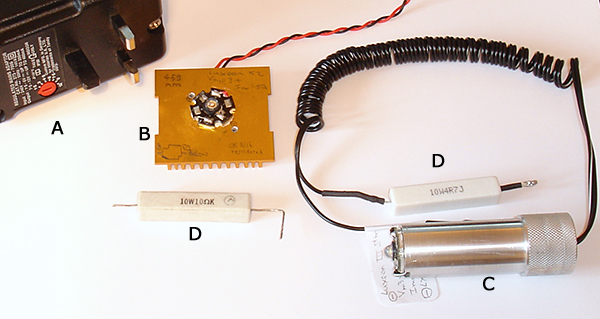
|
Stroboscopic features for microscopy?
As noted above, the two LED controllers with digital operation have multiple stroboscopic modes. Most are multi-frequency cycles for e.g. Christmas LED light strips but one mode is a single frequency which can be controlled in ten steps (frequency limits unknown). These modes were very distracting to my eyes if accidentally activated but did wonder if this mode had potential value as a stroboscope for stopping or slowing movement, e.g. cilia
on microorganisms, heartbeats on multicellular organisms. As remarked, I'm a latecomer to commercial LED controllers and some readers may well have explored this feature and would be interested to hear if of use. (Stopping action using other stroboscopic techniques is well established in microscopy.)
Comments to the author David Walker are welcomed.
©
Microscopy UK or their contributors.
Published
in the October 2016 edition of Micscape.
Please
report any Web problems or offer general comments to
the
Micscape
Editor
.
Micscape
is the on-line monthly magazine of the Microscopy UK web
site at
Microscopy-UK
©
Onview.net Ltd, Microscopy-UK, and all contributors 1995
onwards. All rights reserved.
Main site is at
www.microscopy-uk.org.uk.
 LEDs have allowed the microscopy hobbyist to experiment with a wide variety of lighting projects both for the compound and stereo microscope. Typical projects include converting a microscope's illumination from incandescent sources, fluorescence studies, epi work or exploring recently reported lighting techniques that are particularly suited to LEDs such
as the
work of Dr Kevin Webb using concentric LED rings or the multi-mode lighting techniques described by Prof. Jörg Piper and Timm Piper.
LEDs have allowed the microscopy hobbyist to experiment with a wide variety of lighting projects both for the compound and stereo microscope. Typical projects include converting a microscope's illumination from incandescent sources, fluorescence studies, epi work or exploring recently reported lighting techniques that are particularly suited to LEDs such
as the
work of Dr Kevin Webb using concentric LED rings or the multi-mode lighting techniques described by Prof. Jörg Piper and Timm Piper.

 LED dimmer with analogue intensity control
LED dimmer with analogue intensity control


